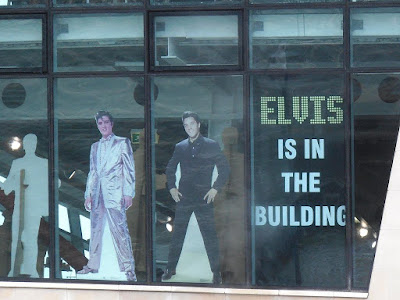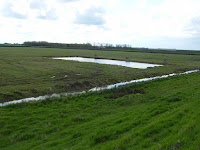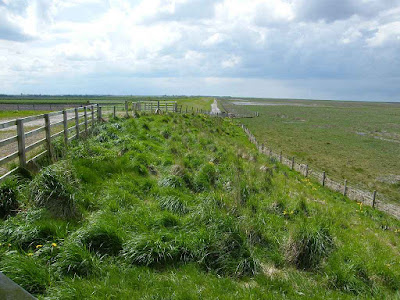Weather: Dull, grey and cold, but just about remaining
dry.
Location: An historical day in Liverpool.
Distance: 0 miles.
Total distance: 3348 miles.
Terrain: Pavements.
Tide: In, mostly.
Rivers: None.
Ferries: None.
Piers: None.
Kissing gates: None.
Pubs: ‘Baltic Fleet’ where Colin drank Wapping ‘Mirie’s Wapping Bitter’. I tried ‘Ruby Tuesday’ cider but I didn’t like it, so I had Stowford Press. ‘Vernon Arms’ where Colin had Peerless ‘Triple Blond’ and Boggart Hole Clough ‘Rum Porter’. I didn’t feel like any more drink.
‘English Heritage’ properties: None.
Ferris wheels: None.
Diversions: None.
How we got there and back: We were staying in our caravan near Southport. This morning we caught a bus from very near our caravan park to Liverpool bus station.
At the end we caught the bus back to our caravan park.
Three days later we towed our caravan home to Malvern.
The bus we took into Liverpool delivered us very near Lime Street Station. After using the loo in a nearby Weatherspoon’s, we walked down through the pedestrianised shopping area to Albert Dock. On the way we called in at the Tourist Information Centre to pick up a street map.
Albert Dock was built in 1846. It was revolutionary in its time because the dock and all the associated warehouses were built from stone and metal, no wood. It was built to last! The ships were loaded and unloaded directly into the warehouses. But 20th century shipping required a very different kind of dock, and its use declined until it stood derelict from 1972 to 1984. Then it was rejuvenated, and is now a major tourist attraction. There were several tall ships in the dock when we arrived there, and we watched one sail through a lock.
We walked along the waterfront to view the ‘Liver Birds’ buildings. The Liver Birds have become a symbol of the city of Liverpool, and the two bird sculptures on top of the Royal Liver Building are loosely based on cormorants.
This is a very appropriate bird for our Round-Britain-Walk — we must have seen hundreds of them standing on rocks or similar, mostly holding their wings out to dry.
We passed a number of sculptures along the waterfront. There was the pop singer, Billy Fury.
There was a sculpture of a family of migrants wearing 19th century clothes; we couldn’t make out whether they were immigrants — from Ireland perhaps — or emigrants on their way to the Americas.
(My father hatched a plan, in 1940, to cycle to Liverpool and board a ship to America should Hitler manage to invade. Thank goodness he never had to carry it out.)
There was a sculpture which we didn’t understand, of what looked like giant ear trumpets and stone bollards fallen over in a heap. What is the significance of that?
There were a number of brightly coloured animals with pictures of pop stars and other squiggles and drawings all over them — we thought they looked tacky.
And we were amused to see that Elvis (The King!) was supposedly in a building we passed, but we didn’t enter to see if it was true!
Further on we came to a cruise ship docked — it was the Queen Mary 2. A luxury cruise liner, but a bit small by today’s standards. Perhaps that’s not a bad thing, “small is beautiful” so ‘tis said. Our one trip on a cruise liner, Balmoral, back in 2010 put us off cruise holidays for life — too impersonal because they are so big!
We retraced our steps to Albert Dock, and then continued a bit further because Colin was anxious to visit a ‘real ale’ pub called Baltic Fleet.
We passed a number of narrowboats moored in the dock because, of course, the Leeds to Liverpool Canal has been restored fully and is much used by leisure craft. We found the pub eventually, and while we were in there we had a bite of lunch at a very reasonable price.
I was anxious to go on the giant Ferris wheel, the Wheel of Liverpool. It is smaller than the London Eye, but we did go round four times so we felt it was worth it. Not really much to see, however. Liverpool was so badly bombed during the War, sixties-type square and characterless buildings have sprung up in every nook and cranny.
It was fun to ride though.
We found a café because we were dying for a cup of tea. Suitably refreshed, we returned to the shopping area to seek out the famous Cavern Club — where the Beatles rose to fame — and the “Wall of Fame”.
What a load of rubbish! The whole area has been flattened and completely rebuilt since the sixties, the only remaining artefact being the original door of the Cavern Club. There it is, looking very out of place in the modern shopping precinct, with the words, “You are here! Original entrance to the Cavern Club” written along the top.
Enough of this tosh! Colin wanted to visit another ‘real ale’ pub called the Vernon Arms which was nearby.
On the way we passed a small sculpture of the Beatles — over-rated in my opinion, they were just lucky enough to be in the right place at the right time, when everyone wanted to shake off the shackles of the past and be free! When we’d “never had it so good”, and changed our hairstyles, our fashions, our manners and our behaviour. When we wanted to each go our own way and felt we were beholden to nobody. But as to amazing music — No! those pop singers of the sixties were popular because they were different, and that is what we wanted at the time. Having said all that, I quite liked the Beatles music. Well……most of it.
We found the Vernon Arms, but I’d had enough beer for one day. Colin said it was much better than the other pub, he was obviously in heaven! So I sat about until he had sampled two of the many beers on offer.
We made our way back to the bus station. We popped into Weatherspoon’s for the loo again, and when we came out there was a parade going past. A lot of drumming and giant puppets — we didn’t know what it was all about but it lent a wonderful atmosphere to the proceedings. A lovely end to an interesting day!
Location: An historical day in Liverpool.
Distance: 0 miles.
Total distance: 3348 miles.
Terrain: Pavements.
Tide: In, mostly.
Rivers: None.
Ferries: None.
Piers: None.
Kissing gates: None.
Pubs: ‘Baltic Fleet’ where Colin drank Wapping ‘Mirie’s Wapping Bitter’. I tried ‘Ruby Tuesday’ cider but I didn’t like it, so I had Stowford Press. ‘Vernon Arms’ where Colin had Peerless ‘Triple Blond’ and Boggart Hole Clough ‘Rum Porter’. I didn’t feel like any more drink.
‘English Heritage’ properties: None.
Ferris wheels: None.
Diversions: None.
How we got there and back: We were staying in our caravan near Southport. This morning we caught a bus from very near our caravan park to Liverpool bus station.
At the end we caught the bus back to our caravan park.
Three days later we towed our caravan home to Malvern.
The bus we took into Liverpool delivered us very near Lime Street Station. After using the loo in a nearby Weatherspoon’s, we walked down through the pedestrianised shopping area to Albert Dock. On the way we called in at the Tourist Information Centre to pick up a street map.
Albert Dock was built in 1846. It was revolutionary in its time because the dock and all the associated warehouses were built from stone and metal, no wood. It was built to last! The ships were loaded and unloaded directly into the warehouses. But 20th century shipping required a very different kind of dock, and its use declined until it stood derelict from 1972 to 1984. Then it was rejuvenated, and is now a major tourist attraction. There were several tall ships in the dock when we arrived there, and we watched one sail through a lock.
We walked along the waterfront to view the ‘Liver Birds’ buildings. The Liver Birds have become a symbol of the city of Liverpool, and the two bird sculptures on top of the Royal Liver Building are loosely based on cormorants.
This is a very appropriate bird for our Round-Britain-Walk — we must have seen hundreds of them standing on rocks or similar, mostly holding their wings out to dry.
We passed a number of sculptures along the waterfront. There was the pop singer, Billy Fury.
There was a sculpture of a family of migrants wearing 19th century clothes; we couldn’t make out whether they were immigrants — from Ireland perhaps — or emigrants on their way to the Americas.
(My father hatched a plan, in 1940, to cycle to Liverpool and board a ship to America should Hitler manage to invade. Thank goodness he never had to carry it out.)
There was a sculpture which we didn’t understand, of what looked like giant ear trumpets and stone bollards fallen over in a heap. What is the significance of that?
There were a number of brightly coloured animals with pictures of pop stars and other squiggles and drawings all over them — we thought they looked tacky.
And we were amused to see that Elvis (The King!) was supposedly in a building we passed, but we didn’t enter to see if it was true!
Further on we came to a cruise ship docked — it was the Queen Mary 2. A luxury cruise liner, but a bit small by today’s standards. Perhaps that’s not a bad thing, “small is beautiful” so ‘tis said. Our one trip on a cruise liner, Balmoral, back in 2010 put us off cruise holidays for life — too impersonal because they are so big!
We retraced our steps to Albert Dock, and then continued a bit further because Colin was anxious to visit a ‘real ale’ pub called Baltic Fleet.
We passed a number of narrowboats moored in the dock because, of course, the Leeds to Liverpool Canal has been restored fully and is much used by leisure craft. We found the pub eventually, and while we were in there we had a bite of lunch at a very reasonable price.
I was anxious to go on the giant Ferris wheel, the Wheel of Liverpool. It is smaller than the London Eye, but we did go round four times so we felt it was worth it. Not really much to see, however. Liverpool was so badly bombed during the War, sixties-type square and characterless buildings have sprung up in every nook and cranny.
It was fun to ride though.
We found a café because we were dying for a cup of tea. Suitably refreshed, we returned to the shopping area to seek out the famous Cavern Club — where the Beatles rose to fame — and the “Wall of Fame”.
What a load of rubbish! The whole area has been flattened and completely rebuilt since the sixties, the only remaining artefact being the original door of the Cavern Club. There it is, looking very out of place in the modern shopping precinct, with the words, “You are here! Original entrance to the Cavern Club” written along the top.
Enough of this tosh! Colin wanted to visit another ‘real ale’ pub called the Vernon Arms which was nearby.
On the way we passed a small sculpture of the Beatles — over-rated in my opinion, they were just lucky enough to be in the right place at the right time, when everyone wanted to shake off the shackles of the past and be free! When we’d “never had it so good”, and changed our hairstyles, our fashions, our manners and our behaviour. When we wanted to each go our own way and felt we were beholden to nobody. But as to amazing music — No! those pop singers of the sixties were popular because they were different, and that is what we wanted at the time. Having said all that, I quite liked the Beatles music. Well……most of it.
We found the Vernon Arms, but I’d had enough beer for one day. Colin said it was much better than the other pub, he was obviously in heaven! So I sat about until he had sampled two of the many beers on offer.
We made our way back to the bus station. We popped into Weatherspoon’s for the loo again, and when we came out there was a parade going past. A lot of drumming and giant puppets — we didn’t know what it was all about but it lent a wonderful atmosphere to the proceedings. A lovely end to an interesting day!







































































